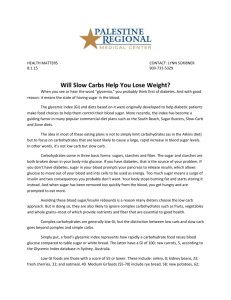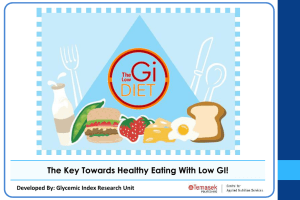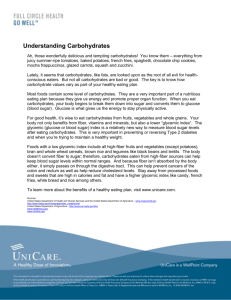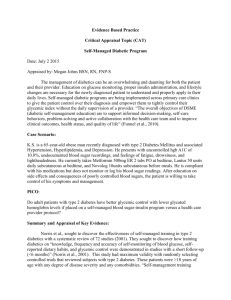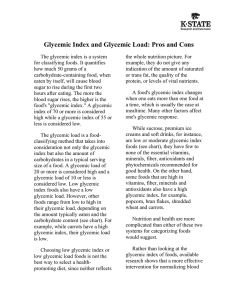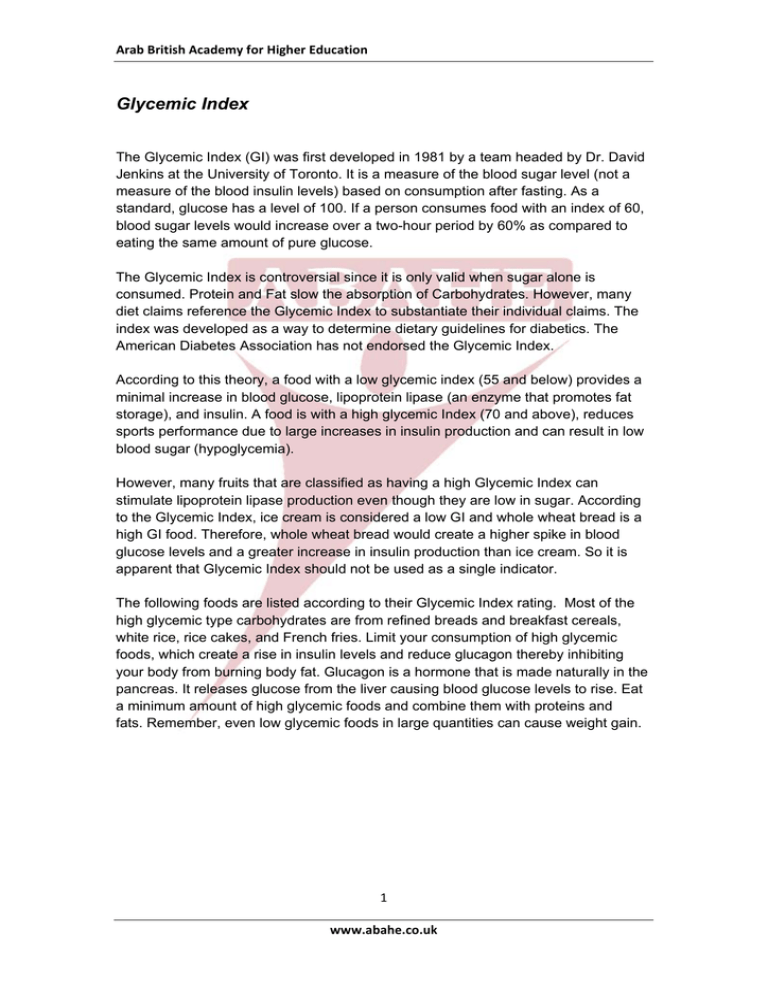
Arab British Academy for Higher Education Glycemic Index
The Glycemic Index (GI) was first developed in 1981 by a team headed by Dr. David
Jenkins at the University of Toronto. It is a measure of the blood sugar level (not a
measure of the blood insulin levels) based on consumption after fasting. As a
standard, glucose has a level of 100. If a person consumes food with an index of 60,
blood sugar levels would increase over a two-hour period by 60% as compared to
eating the same amount of pure glucose.
The Glycemic Index is controversial since it is only valid when sugar alone is
consumed. Protein and Fat slow the absorption of Carbohydrates. However, many
diet claims reference the Glycemic Index to substantiate their individual claims. The
index was developed as a way to determine dietary guidelines for diabetics. The
American Diabetes Association has not endorsed the Glycemic Index.
According to this theory, a food with a low glycemic index (55 and below) provides a
minimal increase in blood glucose, lipoprotein lipase (an enzyme that promotes fat
storage), and insulin. A food is with a high glycemic Index (70 and above), reduces
sports performance due to large increases in insulin production and can result in low
blood sugar (hypoglycemia).
However, many fruits that are classified as having a high Glycemic Index can
stimulate lipoprotein lipase production even though they are low in sugar. According
to the Glycemic Index, ice cream is considered a low GI and whole wheat bread is a
high GI food. Therefore, whole wheat bread would create a higher spike in blood
glucose levels and a greater increase in insulin production than ice cream. So it is
apparent that Glycemic Index should not be used as a single indicator.
The following foods are listed according to their Glycemic Index rating. Most of the
high glycemic type carbohydrates are from refined breads and breakfast cereals,
white rice, rice cakes, and French fries. Limit your consumption of high glycemic
foods, which create a rise in insulin levels and reduce glucagon thereby inhibiting
your body from burning body fat. Glucagon is a hormone that is made naturally in the
pancreas. It releases glucose from the liver causing blood glucose levels to rise. Eat
a minimum amount of high glycemic foods and combine them with proteins and
fats. Remember, even low glycemic foods in large quantities can cause weight gain.
1 www.abahe.co.uk Arab British Academy for Higher Education Gylcemic Food Table
LOW GLYCEMIC FOODS 20-49 PERCENT
• All bran cereals
• Apples
• Apple juice
• Barley
• Berries
• Black-eyed peas
• Bulgur
• Butter beans
• Cherries
• Grapefruit
• Grapes
• Ice Cream
• Milk
• Muesli cereal
• Navy Beans
• Oranges
• Peaches
• Peanuts
• Pears
• Peas
• Plums
• Strawberries
• Soybeans
• Wild rice
• Yogurt (no added sugar)
MODERATE GLYCEMIC FOODS 50-69 PERCENT (LIMIT CONSUMPTION)
• Basmati Rice
• Beets
• Buckwheat
• Carrots
• Cereal (low sugar)
• Corn on the cob
• Lima Beans
• Oatmeal
• Pasta
• Peas
• Potatoes (red, white)
• Potato Chips
• Pumpernickel bread
• Raisins
• Spaghetti
• Sourdough bread
• Sucrose (Table Sugar)
• Sweet Potato
• Whole wheat bread (100% stone ground)
HIGH GLYCEMIC FOODS 70-100 PERCENT
• Apricots
• Bagels
• Bananas (ripe)
• Breakfast cereals (refined with added sugar)
• Corn chips
• Corn Flakes
• Corn syrup solids
• Crackers
• Doughnuts
• Muffins
• Pancakes
• Papaya
• Parsnips
• Puffed rice or wheat
• Potato (baked)
• Rice cakes
• Shredded wheat
• Soft drinks & sport drinks (added sugars)
2 www.abahe.co.uk Arab British Academy for Higher Education • Glucose and Glucose polymers (maltodextrin)
• Hamburger and hotdog buns
• Honey
• Jelly beans
• Maltose
• Mango
• Toaster waffles
• Watermelon
• White bread
• White rice
• Whole wheat bread
All Rights Reserved © Arab British Academy for Higher Education 3 www.abahe.co.uk

